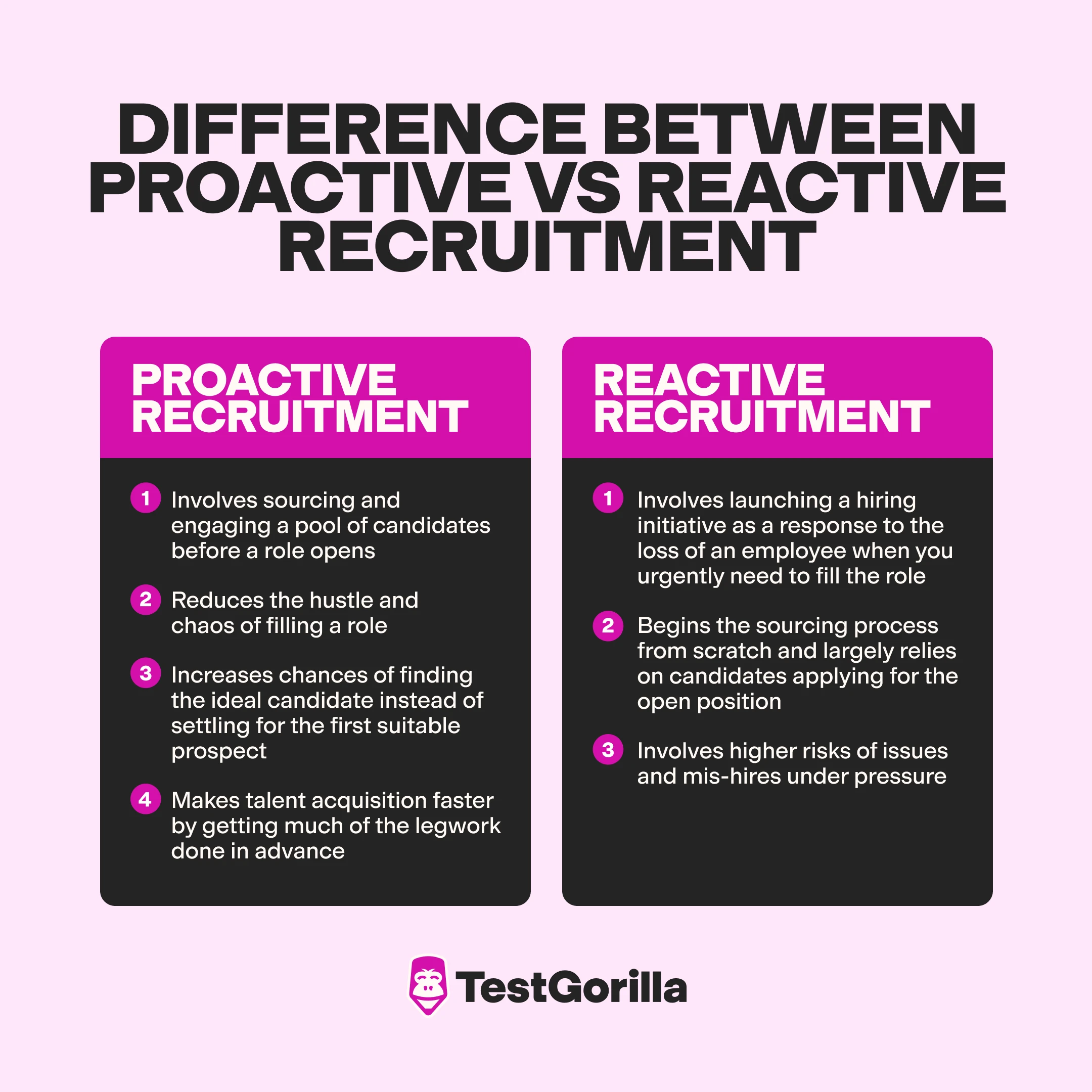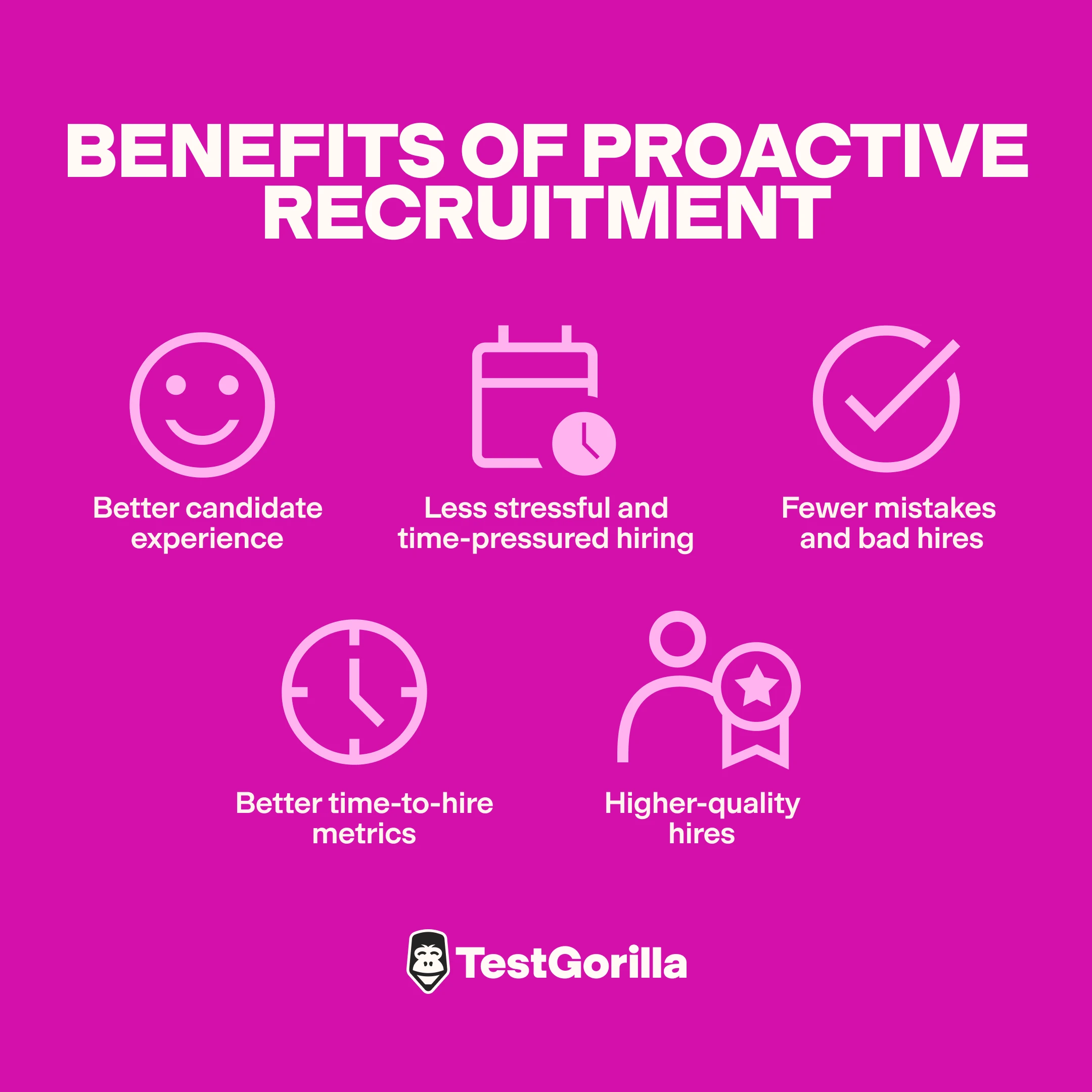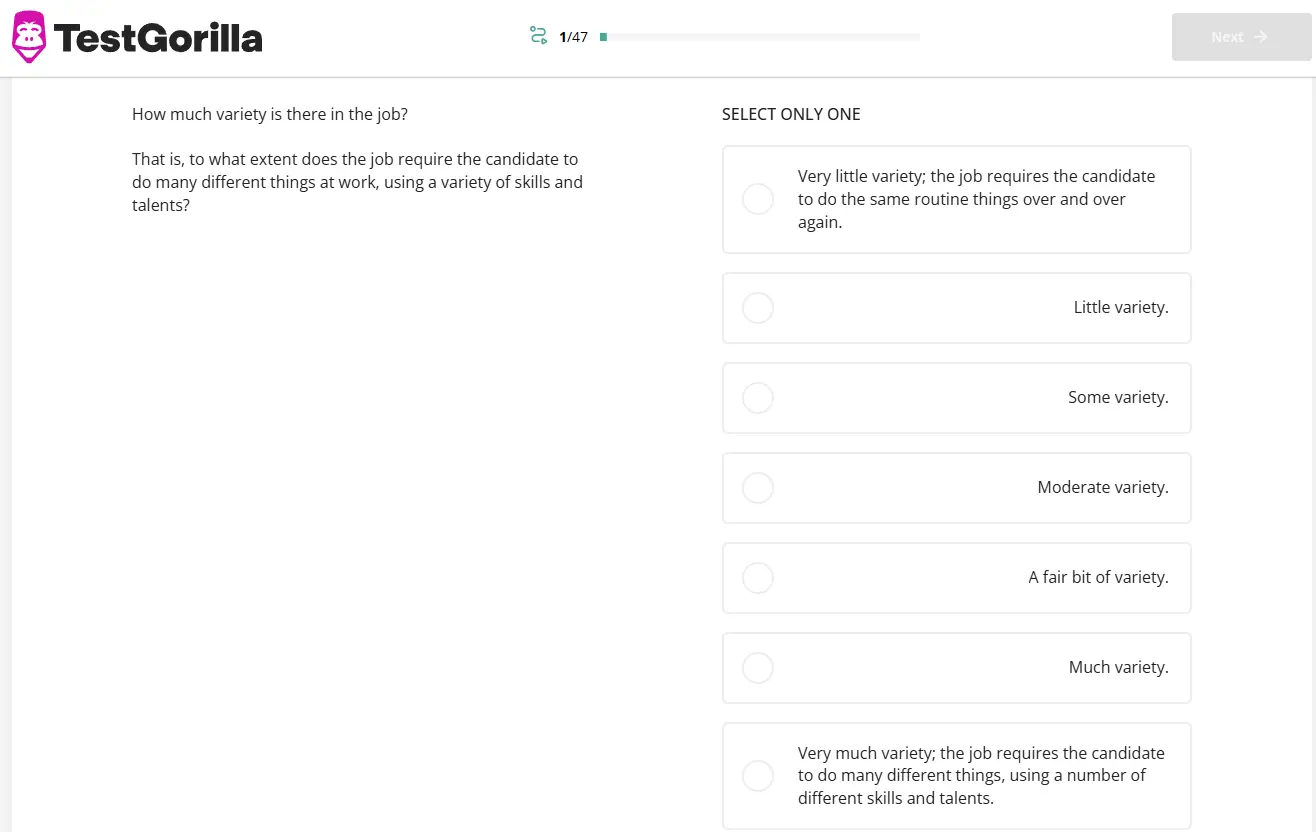Get the most of out proactive recruitment with talent assessments
Finding excellent candidates can be tricky at the best of times.
Delaying it until an employee leaves puts a lot of pressure on you to fill the vacated position quickly and increases the risk of hiring mistakes.
With proactive recruitment, you source and engage talent before it becomes an emergency, so when hiring needs arise, you can jump straight to evaluations and hire the right person.
This article covers the definition of proactive recruitment, discusses its top benefits, and lays out the six phases that make a stellar proactive process, including testing for skills.
What is proactive recruitment?
Proactive recruitment is identifying, sourcing, and attracting job candidates before you need them. This streamlines the hiring process by giving recruiters a vetted talent pipeline to draw from when they need to fill a role.
Proactive recruitment strategies usually entail:
Assessing your company’s skill gaps
Determining potential future positions
Building an internal and external talent pool
Nurturing potential candidates
Reaching out to your now-ready talent pool when a role opens
Proactive recruitment strategies get ahead of hiring demand and enable hiring teams to harness a more controlled and effective hiring process instead of simply being at the mercy of the job market (which can feel like the roll of the dice).
It makes the hiring process simpler and less hectic and promotes better candidate outcomes.
Proactive vs reactive recruitment: What's the difference?
Proactive and reactive recruitment are two hiring tactics with similar-sounding names but different meanings:
Although it doesn’t eliminate the possibility of being surprised by a suddenly vacant role you need to fill, proactive recruitment gives you a head start and better odds at a successful hire.
The benefits of proactive recruitment
LinkedIn’s research estimates that passive candidates make up 70% of the global workforce.
While it’s technically possible to target this passive talent with reactive strategies, reactive hiring isn't effective because of the urgency involved.
Proactive recruitment is all about engaging and nurturing talent in advance, which builds a positive rapport with them, gives you more options to choose from, and yields the best long-term results as you’re able to engage passive candidates.
Here are the specific benefits of proactive recruitment:
Benefit | Description |
Better candidate experience | Proactive sourcing gives you the foundation to build stronger relationships in less time, which improves the candidate experience |
Less stressful and time-pressured hiring | Working against the clock puts more pressure on you, increasing stress and decreasing the chances of finding the ideal candidate |
Fewer mistakes and bad hires | Proactive sourcing improves the quality of hire and reduces the risk of mis-hires |
Better time-to-hire metrics | Working from a talent pool rather than from scratch speeds up the process exponentially |
Higher-quality hires | Proactive recruitment opens up a wide talent pool, which means finding the best, not just someone at the right place and time to fill the gap |
The best insights on HR and recruitment, delivered to your inbox.
Biweekly updates. No spam. Unsubscribe any time.
A step-by-step approach to the proactive recruitment process
The typical five phases of proactive recruiting are:
Find
Engage
Nurture
Attract
Convert
However, we’re going to rework things a bit. Our optimized approach can help you establish a stronger, more effective process.
Proactive recruitment steps: Summary table
Phase | Description |
1. Identify your company’s skill gaps and expected future positions | Assess your workforce’s current skills and your company’s future needs to find out where you stand |
2. Find candidates, both internally and externally, and build a talent pool | Try a variety of strategies to build a healthy talent pool, such as dropping experience requirements, using project-based workers, and adopting skills-based practices |
3. Engage and connect with potential candidates | Reach out and build a relationship with likely prospects |
4. Reach out to the candidates that match the open position when a role arises | Let your talent pool know when a role opens and encourage them to apply |
5. Convert them into your next hire using a skills-based approach | Use skills-based hiring to assess your candidates’ real capabilities |
6. Keep unsuccessful candidates in your talent pool for future opportunities | Set aside applicants for another future role, ensuring great talent doesn’t go to waste and keeping your talent pool full |
1. Identify your company’s skill gaps and expected future positions
A skills-gap analysis assesses which skills your workforce has and which skills it’s lacking. This shows you which positions you might need to fill in the future so you can start sourcing candidates.
Here’s an example of a basic skills gap analysis:
Define both short-term and long-term goals
Identify the skills you need to achieve these goals
Determine if you need to do a team-based or individual-based assessment
Measure skills and identify gaps
The information learned from your skills gap analysis helps you build an ideal candidate persona.
This is a representation of your ideal hire for a given position, usually describing the necessary skills, expected salary, and desired traits.
For example, this ideal candidate persona would help you hire a backend developer:
Criteria category | Criteria |
Hard skills | |
Soft skills | |
Salary | $70,000-$90,000 |
Traits and personality | Inquisitive, solutions-oriented, agreeable, open |
Doing this in advance guides your sourcing efforts and makes targeted recruitment possible, even for the most specific or rare niche skills.
Make data-driven decisions with TestGorilla
Talent assessments give you complete, objective information about your employees’ and applicants’ skill sets. Learn how easy it is to assess key skills with TestGorilla today.
2. Find candidates, both internally and externally, and build a talent pool
Here are a few of our top strategies for creating an excellent talent pool that suits your company culture, values, and expected needs:
Drop unnecessary requirements from your new job postings: Years of experience and degrees don’t always indicate capability, and dropping them from your list of “must-haves” opens the door for many more candidates.
Switch to skills-based hiring: Skills-based hiring focuses on hiring people with the skills to do the job, regardless of their background.
Include people with criminal records in your talent pool: Fair-chance hiring practices increase your talent pool by 70 to 100 million people (and that’s only America).
Offer flexible working arrangements: These arrangements are attractive to many candidates, but they’re necessary for some people, such as working parents.
Use project-based workers: Accepting project-based workers expands the talent pool greatly. Millions of people only work as contractors and freelancers.
Build a strong employer brand: Facilitating positive experiences with employees and applicants creates a good reputation, helping you attract more candidates in the future.
Build an internal talent pool: Your current employees are one of the best sources of future talent. They already possess company knowledge and are accustomed to your organizational culture, and you know what their skill set is.
Internal mobility is your secret weapon for quickly securing high-quality candidates and increasing employee satisfaction and retention.
3. Engage and connect with potential candidates
Creating a solid rapport with candidates builds trust and increases the chances of positive responses once you need them for a role. It’s an integral part of your proactive recruitment efforts. The key is to meet people where they are and engage them meaningfully:
Connect with them over social media: Job boards such as LinkedIn are excellent tools for building relationships with candidates and helping them learn about your organization naturally.
Talk to them like people: Stay human with semi-formal language and light-hearted dialogue. This is a conversation, not a thesis.
Understand their skills and strengths: Go into the conversation with an understanding of the candidate's work and specialization.
Make it primarily about them: Ask about their achievements, skills, and interests. Mention your company, but don’t be pushy or try to hard sell.
Candidate engagement is much easier to handle when you have HR recruiting software, such as a andidate relationship management (CRM) system or a recruitment marketing platform.
A CRM system helps you identify and build a talent pool, manage and nurture potential candidates, and continuously improve through analytics.
Check out our guide on online recruitment platforms to read more on the subject.
4. Reach out to the candidates that match the open position when a role arises
You can use your CRM to pull up relevant information on the candidates before you reach out, such as your previous conversations and any important topics you covered.
It pays to be personal. Mass email blasts aren’t specific or thoughtful enough. Consider the applicants’s interests and career goals. At the least, show them you’ve checked their LinkedIn profile – you don’t want to ask them basic questions that are already answered in their headline.
You need to provide solid incentives to attract the best job seekers, so pull them in with personalization and an excellent candidate experience.
Also, ensure your job applications are:
Short and concise
Easy to apply to
Mobile-friendly
These features are more important than they appear. One study showed that 54% of Gen Z job seekers don’t even complete an application if the process is long or outdated.
For more tips on how to make a better application process, read our guide on how to increase job applicants.
5. Convert them into your next hire using a skills-based approach
Filling your talent pipeline for proactive recruitment only works if you have an objective way to verify they match your job requirements.
This is where resumes fall short. They provide incomplete, often incorrect information and disqualify good candidates for arbitrary reasons. Relying on resumes leaves you with fewer options and increases the risk of expensive staffing mistakes.
But there is a better way. Skills-based hiring is the practice of evaluating candidates using talent assessments and hiring them based on their real compatibility with the role requirements.
TestGorilla’s talent assessments consist of up to five tests to give you a complete and unbiased picture of your applicants.
Subject matter experts created our extensive test library to quantitatively evaluate a variety of traits and skills for any role. This includes candidates’ personality and core beliefs, expectations from work, cognitive performance, and both their hard and soft skills.
Some of these tests are uniform, but others are totally customized to your company.
For example, the Motivation test requires you to fill out a questionnaire that sets the benchmark values for candidate testing. Here’s the first question:
After prospective candidates take this test, their answers are evaluated against yours and ranked from best to worst match.
Nexus HR streamlined their recruitment by taking advantage of TestGorilla’s customization functionalities in their assessments:
The option to add basic custom qualifying questions and quickly screen out unqualified candidates
The option to create and use your own tests and truly tailor the criteria to a T
The optional one-way video interview
Widen your talent pool using talent assessments
TestGorilla’s 400+ skills tests quantitatively measure candidates’ abilities, improve the candidate experience, and help you attract more talent. Get started today for free.
The results of using this approach:
A quicker and more data-driven recruiting process resulting in the best match for any open role
An improved candidate experience and a positive company image help to attract the best talent in the future
Carefully vetted and qualified adds to your talent pool for proactive global recruitment
6. Keep unsuccessful candidates in your talent pool for future opportunities
Some candidates may not work out, but they might be right for another position.
One of the best proactive recruiting practices is to keep all unsuccessful candidates in your talent pool for future opportunities. You sourced them in the first place, so you know they’re a solid candidate.
Keeping them on the back burner ensures that none of that top talent you sourced goes to waste. Instead, you have a recruitment pipeline ready to be tapped when needed. It’s almost a shortcut – it’s essentially step two again, but with all the research and nurturing work out of the way.
Build a healthy talent pool with proactive recruitment
The best part of having a good proactive recruitment process is knowing you’re always one step ahead.
With proactive recruiting ideas like assessing skill gaps, engaging potential candidates, and building a healthy talent pool, you can transform hiring from a stressful and hectic ordeal into a smooth, streamlined stroll.
Check out TestGorilla’s live demo and product tour to see how we can help.
And once you’re ready to revamp your hiring strategy, get started for free with your Free forever plan.
Proactive recruitment FAQs
Below are answers to some common questions about proactive recruiting techniques.
What is a proactive approach in the hiring process?
Proactive recruiting means you take the initiative to source talent on an ongoing basis instead of waiting for the moment when you urgently need to hire. This way, even if you’re caught off guard when an employee leaves, you’re well prepared to handle it. Proactive global recruitment gives you the widest talent pool to choose from and lets you hire faster by essentially skipping the first step (sourcing talent from scratch).
How do you proactively recruit?
Identify your company’s skill gaps and expected future positions
Build a talent pool of both internal and external candidates
Engage and connect with potential candidates
Reach out to the candidates that match the open position when a role arises
Evaluate and convert them into your next hire using a skills-based approach
Keep unsuccessful candidates in your talent pool for future job openings
What is an example of proactive HR?
Imagine you just hired a writer. Seven excellent candidates made it through the evaluation stage but you only had need for one. What about the other six? With proactive hiring, you save them in your candidate pool for the future. That way, if you land another client or one of your team members drops out, you have a bench of qualified candidates who could jump in.
Other proactive recruitment examples include accepting applications on a rolling basis or casually engaging talent on LinkedIn before you need them.
You've scrolled this far
Why not try TestGorilla for free, and see what happens when you put skills first.




















